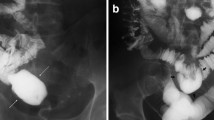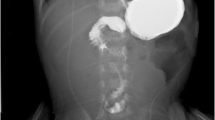Abstract
The mesenteric small bowel is the portion of the gastrointestinal tract which begins at the duodenojejunal flexure and ends at the ileocecal valve. It is 3 m long and it is divided into jejunum and ileum. It is attached to the posterior abdominal wall by fan-shaped mesentery which contains the blood vessels, lymphatics and nerves.
There are multiple diseases which can present during the neonatal period, such as atresias, meconium abnormalities, cysts, and malrotation. In this chapter we summarise these diseases, with their clinical presentation, imaging modality of choice, and radiological findings.
Access this chapter
Tax calculation will be finalised at checkout
Purchases are for personal use only
Similar content being viewed by others
References
Berrocal T, et al. Congenital anomalies of the small intestine, colon and rectum. Radiographics. 1999;19:1219–36.
Bloom DA, Slovis TL. Congenital anomalies of the gastrointestinal tract. In: Slovis TL, editor. Caffey’s pediatric diagnostic imaging, vol. II. 11th ed. Philadelphia: Elsevier; 2008. p. 188–235.
De Bruyn R. Pediatric ultrasound. How, why and when. London: Elsevier; 2005.
Donoghue V, Twomey E. The neonatal gastrointestinal tract. In: Carty H et al., editors. Imaging children. New York: Elsevier; 2005. p. 1305–65.
Federle MP, et al. Diagnostic imaging. Abdomen. Manitoba: Amirsys; 2004.
Levy AD, Hobbs CM. From the archives of the AFIP: Meckel diverticulum: radiologic features with pathologic correlation. Radiographics. 2004;24:565–87.
Meyers MA. Dynamic radiology of the abdomen. New York: Springer; 2005.
Netter FH. Atlas of human anatomy. 2nd ed. East Hanover, New Jersey: ICON; 1999.
Pracros JP, Sann L, Genin G, Tran-Minh VA, et al. Ultrasound diagnosis of midgut volvulus: the “whirlpool” sign. Pediatr Radiol. 1992;22:18–20.
Ryan S, McNicholas M, Eustace S. Anatomy for diagnostic imaging. 3rd ed. Philadelphia: Elsevier; 2011.
Sadler TW. Langman’s medical embriology. 8th ed. Philadelphia: Lippincott Williams & Wilkins; 2000.
Yousefzadeh DK, Kang L, Tessicini L. Assessment of retromesenteric position of the third portion of the duodenum: an US feasibility study in 33 newborns. Pediatr Radiol. 2010;40:1476–84.
Author information
Authors and Affiliations
Corresponding author
Editor information
Editors and Affiliations
Rights and permissions
Copyright information
© 2013 Springer-Verlag Berlin Heidelberg
About this entry
Cite this entry
Caro, P., Ryan, S. (2013). Small Bowel Normal Anatomy and Congenital Anomalies. In: Hamm, B., Ros, P.R. (eds) Abdominal Imaging. Springer, Berlin, Heidelberg. https://doi.org/10.1007/978-3-642-13327-5_42
Download citation
DOI: https://doi.org/10.1007/978-3-642-13327-5_42
Publisher Name: Springer, Berlin, Heidelberg
Print ISBN: 978-3-642-13326-8
Online ISBN: 978-3-642-13327-5
eBook Packages: MedicineReference Module Medicine




